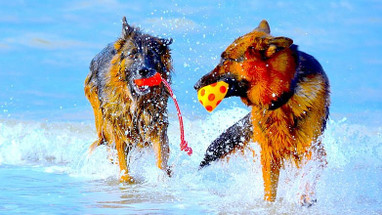Teaching Toy Sharing
Q: How can I teach my dog to share? I have another dog and he will fight with her if she is chewing on a toy and he wants it- even if the toy isn’t his. Can you help?
A: There are a number of conditions that may facilitate sharing of toys or other objects amongst dogs. Within your household, pertinent conditions that may facilitate sharing include the emotional state of your dogs, the perceived value of the objects, the purpose of the object, the general relationship between the dogs, the status differential between the dogs, and the probability and risk of your second dog’s non-compliance.
Consequently, solutions include:
- A proactive stimulation program for the possessive dog. The program should include 45 minutes of sensory stimulation (walking), 20 to 40 minutes of rigorous physical stimulation (running, bicycling, ball sprints, swimming), and 10 to 20 minutes of mental stimulation (obedience, trick and/or agility training) on a daily basis.
- Removing all high-valued objects that your dog is most likely to guard. As a second option, you may try placing an abundance of high-valued items in the room, hoping that with such a surplus your dog becomes less possessive. As a third option, you may wish to place the dogs in separate rooms when disseminating high value chew or play objects and immediately pick up the objects and ensconce them in an inaccessible place (e.g., closet) when the dogs are again placed together.
- Purchasing objects that facilitate multiple dog play, provided your possessive dog will assume playful behavior with such an object. For instance, a long thick tug rope is more likely to foster play than a chew bone.
- Employing the services of a professional trainer or behaviorist skilled in the design of programs geared toward improving intra-pack relationships. The preceding is especially relevant if your dogs are typically tense around one another, do not enjoy one another’s company, or fight for reasons other than solely the possession of resources.
- Instituting a leadership and elevation/declination program that installs you clearly as the pack leader and that creates greater status differential amongst your dogs. Intra-pack conflict occurs most frequently when there is rank/status compression versus when there is definitive rank/status separation. Therefore, by expediting the resolution of existing status conflict, you should reduce the frequency and severity of object guarding behavior. You will likely need the services of a competent trainer/behaviorist to design and instruct an effective leadership and elevation/declination program.
- Ignoring the “problem” if the “fights” are becoming less frequent and enduring and do not result in injury. At times, object guarding and possessiveness are a dominant dog’s method of instituting intra-pack elevation/declination training. Consequently, if the behavior does not result in injury and is becoming less frequent and pronounced, then you may be best to ignore the situation, as otherwise you may apply human rules of etiquette and egalitarianism that are inappropriate for your dog pack and that actually may increase the stress level and the probability of injurious fights.
- A comprehensive behavior modification approach. Despite the recommendation communicated in #6, if your dog’s possessive behavior negatively affects your second dog (she is becoming generally more timid, aloof, stressed, anxious, or aggressive) or results in injury to either of the dogs, then you need to take strong preventive measures as described in many of the above recommendations, involve the services of a professional trainer/behaviorist skilled in resolving possessive aggression and issues related to intra-pack dynamics, perform splitting behavior to intervene when your possessive dog acts inappropriately, and/or consider time outs when your possessive dog acts inappropriately.
Even though you appear distressed regarding your dog’s current behavior, by following the advice contained within this newsletter, you should ultimately create a more harmonious household for you and your dogs.
© Copyright Mark Spivak and Comprehensive Pet Therapy, Inc., December 2010, All rights reserved.



